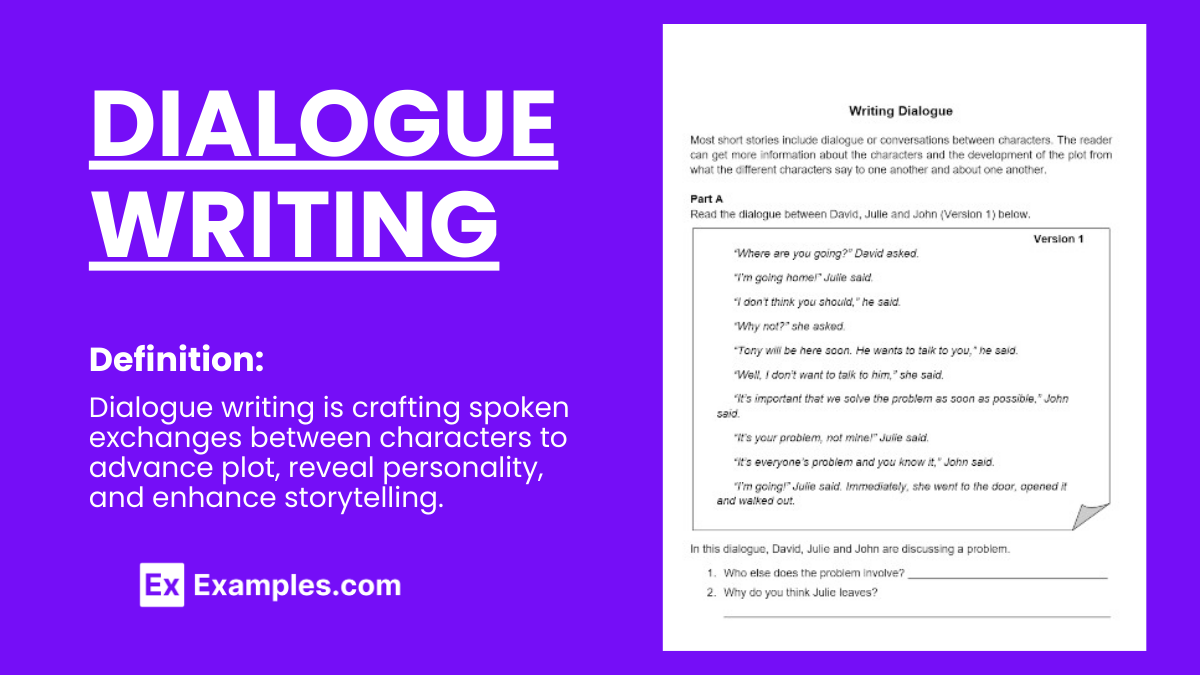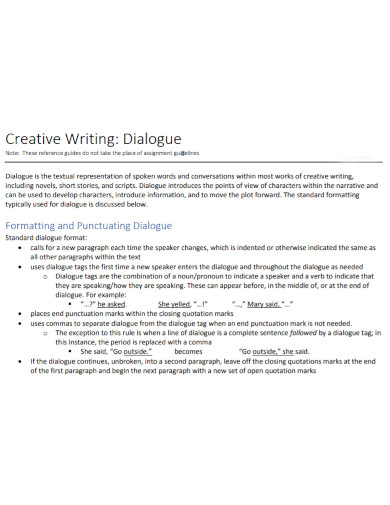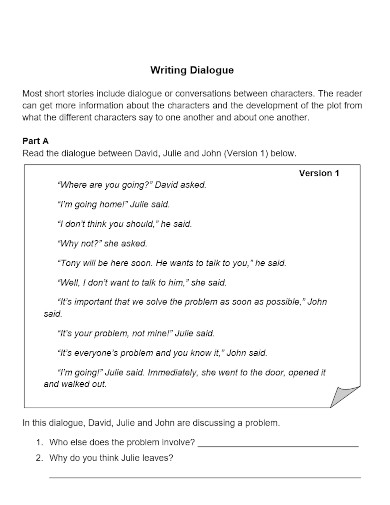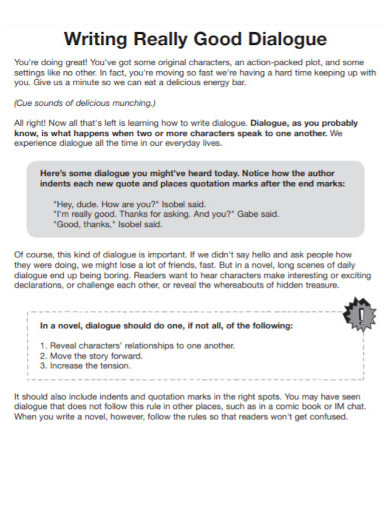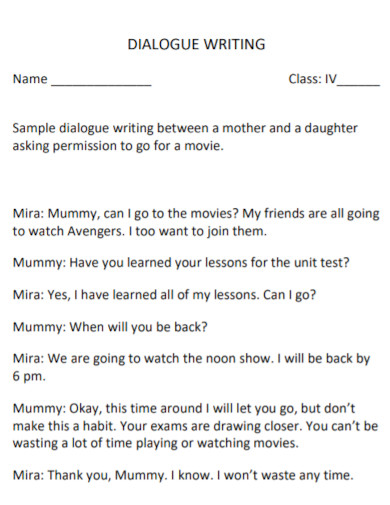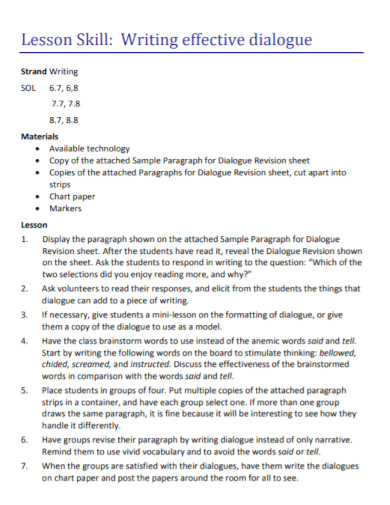6+ Dialogue Writing Examples
We all have been there, when teachers ask us how to write or how to formulate a good dialogue. But how do you write a good dialogue if you have no idea what to write in the first place. This can get tricky but not impossible. To solve this problem, we have some dialogue writing examples you can use. Check it out below.
What Is a Dialogue Writing?
Dialogue writing is the process of crafting conversations between characters in a story or script. It involves creating realistic and engaging exchanges that reveal character traits, advance the plot, and reflect natural speech patterns. Effective dialogue uses proper punctuation, maintains character voice consistency, and enhances the narrative flow.
Dialogue Writing Format
1. Introduction
- Objective: Define the purpose of the dialogue. It could be to advance the plot, reveal character traits, or provide important information.
- Setting: Establish the scene where the dialogue takes place. Setting influences the tone and context of the conversation.
- Characters: Briefly introduce the characters involved in the dialogue, highlighting their personalities and possible motivations for the conversation.
2. Body
- Opening Line: Start with a compelling opening line that grabs attention and sets the tone for the dialogue.
- Exchange Structure:
- Natural Flow: Ensure the conversation flows naturally, mimicking real-life speech patterns. Avoid long monologues unless they serve a specific purpose.
- Conflict or Tension: Incorporate elements of conflict or tension to maintain interest. This could be a disagreement, a misunderstanding, or an emotional reveal.
- Pacing: Control the pacing through sentence length and structure. Short, quick exchanges can increase tension, while longer speeches can provide depth and background.
- Dialogue Tags and Actions: Use dialogue tags (e.g., said, asked) sparingly and actions to convey mood, tone, and character reactions. This helps to show rather than tell the reader about the characters’ emotions and reactions.
- Character Voice: Ensure each character has a distinct voice reflecting their background, personality, and current emotional state. This adds realism and depth to the dialogue.
3. Conclusion
- Resolution or Cliffhanger: Decide whether the dialogue will resolve the conflict introduced or leave it as a cliffhanger to build suspense.
- Transition: Provide a smooth transition out of the dialogue, whether it leads to another scene or ends the chapter. This could be a summary of the outcome, a character’s reflection, or a teaser of what’s to come.
Example of Dialogue Writing
Free Download in Word Free Download in PDFSetting: A small, cozy café in the heart of a bustling city. The sound of light chatter and the aroma of coffee fills the air.
Characters:
- Emma: A young, aspiring writer with a vibrant personality, always seen with a notebook in hand.
- Liam: A software developer with a quiet demeanor but sharp wit, a friend of Emma’s from college.
(Emma spots Liam sitting at a corner table with his laptop and approaches him with a smile.)
Emma: (excitedly) Liam! I didn’t expect to see you here. Working on the next big app?
Liam: (smiling) Hey, Emma. Just trying to, but it’s more bug fixing than creating today. What brings you here?
Emma: (sitting down) I’m working on a story. The café’s ambiance always sparks my creativity. Speaking of stories, I’ve hit a bit of a wall with my latest one.
Liam: Oh? What’s the trouble? Maybe I can help.
Emma: It’s the dialogue. I can’t seem to get it right. It either sounds too stiff or too melodramatic.
Liam: Let’s hear it. Maybe it just needs a fresh pair of ears.
(Emma opens her notebook and reads a portion of her dialogue.)
Emma: “I can’t believe you did this to me,” she cried, “after everything we’ve been through together!”
Liam: I see what you mean. It does sound a bit over the top. Why not tone it down and add some subtlety? Real conversations rarely go full drama.
Emma: (nodding) You’re right. Maybe something like, “I’m just… surprised. I thought we understood each other better.”
Liam: That’s better. It’s more restrained but still conveys a sense of betrayal.
Emma: Thanks, Liam. You always know how to clear the fog. How do you do it?
Liam: (shrugs) I guess it’s just a matter of stepping back and asking, “What would I actually say in this situation?”
Emma: (smiling) Practical as ever. I’m grateful, though. Let me buy you a coffee as thanks.
Liam: (closing his laptop) Deal. But I’m choosing the coffee. Your taste in coffee is as dramatic as your original dialogue.
Emma: (laughs) Fair enough. You’ve got yourself a deal.
(They both stand up, with Emma playfully rolling her eyes at Liam’s comment, and move towards the counter to order their coffees, their conversation light and filled with laughter.)
Dialogue Writing Examples & Templates in PDF
1. Creative Dialogue Writing
2. New Dialogue Writing
3. Dramatic Dialogue Writing
4. Printable Dialogue Writing
5. Dialogue Writing Template
6. Lesson Skill Writing dialogue
Types of Dialogue in Writing
1. Direct Dialogue
Direct dialogue quotes the characters’ spoken words exactly as they are said, enclosed in quotation marks. It’s the most immediate way to present conversations and allows readers to hear characters’ voices directly.
2. Indirect Dialogue
Indirect dialogue paraphrases or summarizes what characters say without quoting them verbatim. It’s useful for conveying the gist of conversations without detailing every word spoken.
3. Inner Dialogue
Inner dialogue reveals a character’s thoughts, feelings, and internal debates, often formatted in italics or introduced with phrases like “he thought” or “she wondered.” It provides direct access to a character’s inner world.
4. Soliloquy
Used mainly in drama, a soliloquy is a speech delivered by a character alone on stage, sharing their thoughts, feelings, or plans directly with the audience. It’s a powerful tool for revealing deep internal conflicts.
5. Monologue
A monologue is a lengthy speech by one character, either alone or to others, that expresses their thoughts or narrates a story. Unlike soliloquies, monologues can be heard by other characters within the work.
6. Expository Dialogue
This type of dialogue is used to convey background information, plot details, or context necessary for understanding the story. It’s a way to inform the audience or readers about critical elements without resorting to narration.
7. Argumentative Dialogue
Argumentative dialogue features a verbal dispute between characters, showcasing their conflicting viewpoints or interests. It’s key for developing tension and exploring different perspectives within the narrative.
8. Flirtatious Dialogue
Flirtatious dialogue is characterized by playful, teasing exchanges that suggest a romantic or sexual interest between characters. It’s often used to build chemistry and hint at developing relationships.
How to Write Dialogue
Writing compelling dialogue is an art that requires attention to detail, a deep understanding of character, and an ear for natural speech patterns. Effective dialogue can elevate a narrative, providing depth to characters and advancing the plot. Here’s a comprehensive guide on how to write dialogue that resonates with readers and feels authentic.
1. Know Your Characters
Understand your characters thoroughly. Consider their personalities, backgrounds, and motivations. This understanding helps you write dialogue that sounds authentic and true to each character.
2. Use Natural Speech Patterns
Write dialogue that mimics how people speak in real life. Use contractions and colloquial language. Avoid overly formal or stilted speech unless it fits a specific character.
3. Keep it Concise
Dialogue should be brief and to the point. Avoid long-winded speeches that can bore the reader. Aim for concise conversations that move the story forward.
4. Show, Don’t Tell
Use dialogue to reveal character traits and advance the plot. Instead of explaining a character’s feelings or background through narration, let their words and interactions convey this information.
5. Use Proper Punctuation
Enclose dialogue in quotation marks. Use commas, periods, question marks, and exclamation points correctly. Proper punctuation helps clarify who is speaking and conveys the intended tone.
6. Break Up Dialogue
Avoid long blocks of uninterrupted dialogue. Break up conversations with actions, descriptions, or internal thoughts. This keeps the reader engaged and provides context for the dialogue.
What makes good dialogue writing?
When you wish to make a good dialogue writing, things to consider would be your grammar, punctuations and the length. Listed below are some things to consider when you want to make a good dialogue writing work:
- Putting yourself in your character’s shoes.
Pretend to be the character you want to write. What is she or he going to do and say. Write that down. Put life in your characters, do not make them too dull.
- Keep moving.
If you think the conversation between characters is confusing enough, do not explain. Let everything fall into place. Even when there is conflict in the dialogue, move on.
- Use actions to break the dialogue.
Interrupt once in a while. This makes the dialogue more sensible and practical when read.
- Read your dialogue out loud.
This helps with finding out if it sounds good or you need to change a few things.
- Lastly, have some fun
When writing the dialogue, remember to have some fun with it. But remember to base it on the theme, the story or the idea you are going for.
Rules in dialogue writing
Use Quotation Marks:
- Enclose spoken words within quotation marks to differentiate dialogue from narration.
- Example: “I can’t believe it’s already Friday,” she said.
Start a New Paragraph for Each Speaker:
- Begin a new paragraph every time a different character speaks to avoid confusion.
- Example:
- “Are you coming with us?” asked John.
- “I’ll catch up later,” replied Mary.
Include Dialogue Tags:
- Use tags like “said,” “asked,” or “replied” to indicate who is speaking. Place the tag after the dialogue or within the sentence.
- Example: “It’s a beautiful day,” he said.
Use Punctuation Inside Quotation Marks:
- Periods and commas should be placed inside the quotation marks. Question marks and exclamation points should be inside if they are part of the dialogue.
- Example: “Are you ready?” she asked.
Keep Dialogue Realistic:
- Write dialogue that mimics natural speech, using contractions and colloquial language. Avoid overly formal or stilted language.
- Example: “I’ll see you later,” instead of “I will see you later.”
Vary Dialogue with Action and Description:
- Break up dialogue with characters’ actions, thoughts, or descriptions to maintain reader interest and provide context.
- Example: “I can’t stay,” she said, grabbing her coat. “There’s something I need to do.”
Common Mistakes to Avoid in Dialogue Writing
Writing dialogue is a crucial aspect of storytelling that can bring characters to life and advance the plot. However, it’s easy to fall into common pitfalls that can make dialogue feel awkward, unnatural, or ineffective. Here are some common dialogue mistakes to avoid:
1. Overusing Dialogue Tags
- Mistake: Relying heavily on adverbs in dialogue tags (e.g., “he said angrily”) or using overly descriptive verbs (e.g., “she exclaimed”).
- Fix: Use simple tags like “said” and “asked” most of the time, and convey emotions through the dialogue itself or through character actions.
2. Writing Unnatural Speech
- Mistake: Crafting sentences that are too perfect or formal, which can make characters sound artificial.
- Fix: Listen to how people speak in real life, noting the contractions, interruptions, and sometimes grammatical inaccuracies, and incorporate these elements into your dialogue to add realism.
3. Ignoring Subtext
- Mistake: Having characters always say exactly what they mean, which can make dialogue feel on-the-nose and lack depth.
- Fix: Use subtext to convey underlying emotions or thoughts. Let readers read between the lines by what is implied rather than explicitly stated.
4. Failing to Differentiate Character Voices
- Mistake: All characters sounding the same, making it hard for readers to distinguish who is speaking without dialogue tags.
- Fix: Develop unique voices for your characters based on their backgrounds, personalities, and experiences. This can include differences in vocabulary, sentence structure, and rhythm.
5. Including Unnecessary Filler
- Mistake: Adding small talk or filler words (like “um,” “well,” “you know”) that don’t serve the plot or character development.
- Fix: Keep dialogue focused and purposeful. While some filler can add realism, use it sparingly and with intention.
6. Using Dialogue as Exposition
- Mistake: Using characters’ conversations to dump information or backstory unnaturally.
- Fix: Reveal necessary information gradually through actions, thoughts, and dialogue that feels organic to the conversation.
7. Not Using Contractions
- Mistake: Avoiding contractions, which can make dialogue sound stilted and formal.
- Fix: Use contractions to create a more natural and relaxed tone, reflecting how people actually speak.
8. Forgetting Character Development
- Mistake: Missing the opportunity to use dialogue for character development, making characters feel flat.
- Fix: Use dialogue to reveal character traits, values, and evolution over time. Let conversations reflect changes in relationships and personal growth.
9. Inconsistent Voice
- Mistake: Characters’ speech patterns changing without reason, leading to inconsistency in voice.
- Fix: Ensure that each character’s way of speaking remains consistent throughout the story, unless changes are part of their development.
10. Not Reading Dialogue Aloud
- Mistake: Not testing the natural flow of dialogue by reading it aloud.
- Fix: Read dialogue aloud to catch awkward phrases, stilted speech, or pacing issues. This can also help ensure the dialogue sounds natural and engaging.
Tips for Dialogue Writing
Crafting engaging dialogue is a powerful technique to captivate readers. Here are ten ways to use dialogue to hook your audience effectively:
1. Start with Conflict
Begin a scene or story with dialogue that introduces conflict or tension between characters. This immediately engages readers by making them wonder about the context and outcome.
2. Use Mystery or Intrigue
Incorporate dialogue that hints at a secret, mystery, or something unknown. Readers will be hooked by the desire to uncover the truth or understand the mystery.
3. Create Emotional Resonance
Dialogue that conveys strong emotions—whether joy, anger, sadness, or fear—can create a powerful connection with readers. They’ll be drawn into the emotional journey of the characters.
4. Inject Humor
Witty or humorous dialogue can endear characters to readers and make the narrative more engaging. A clever exchange can be a refreshing hook that keeps readers entertained.
5. Reveal Character Secrets
Use dialogue to reveal secrets or unexpected truths about a character. This not only adds depth to the character but also alters the readers’ understanding of the narrative, keeping them hooked.
6. Incorporate Sharp, Memorable Lines
Craft memorable lines or catchphrases within your dialogue. A striking or poignant piece of dialogue can resonate with readers and make your story stand out.
7. Utilize Subtext
Instead of stating things outright, use dialogue where the true meanings are hidden beneath the surface. Readers will be intrigued by the need to read between the lines and understand the deeper context.
8. Establish Immediate Stakes
Let your characters discuss what’s at stake early on. Knowing what the characters stand to gain or lose makes readers invested in the outcome from the start.
9. Create Dynamic Character Interactions
Showcase the chemistry between characters through their dialogue. Whether it’s a budding romance, a deep-seated rivalry, or an unbreakable friendship, dynamic interactions keep readers hooked.
10. Offer Hints of Backstory
Gradually reveal characters’ backstories through their conversations without resorting to exposition dumps. This encourages readers to piece together the story behind the story, maintaining their interest.
How do I make dialogue sound natural?
Use contractions, slang, and varied sentence lengths. Listen to real conversations for inspiration.
When should I use dialogue tags?
Use tags like “said” or “asked” for clarity, but not excessively. Sometimes, action beats can replace tags.
Can I use dialects or accents in dialogue?
Yes, but sparingly. Too much can be hard to read. Use subtle hints to suggest an accent.
How do I handle interruptions in dialogue?
Use an em dash (—) to indicate an interruption.
Example: “Wait, I didn’t—””No time! Let’s go.”
What is subtext in dialogue?
Subtext is the underlying meaning behind the words spoken, revealing characters’ true feelings without explicit statements.
How do I punctuate dialogue correctly?
Place periods and commas inside quotation marks. Use question marks and exclamation points as appropriate.
Can dialogue reveal character traits?
Yes, dialogue can show personality, background, and emotions. It’s a key tool for character development.
How do I balance dialogue and narration?
Alternate between dialogue and narration to maintain a natural flow and keep the reader engaged.
Should each character have a unique voice?
Yes, each character should have a distinct way of speaking that reflects their personality and background.
How do I edit dialogue effectively?
Read it aloud, cut unnecessary words, and ensure it sounds natural and serves the story’s purpose.



